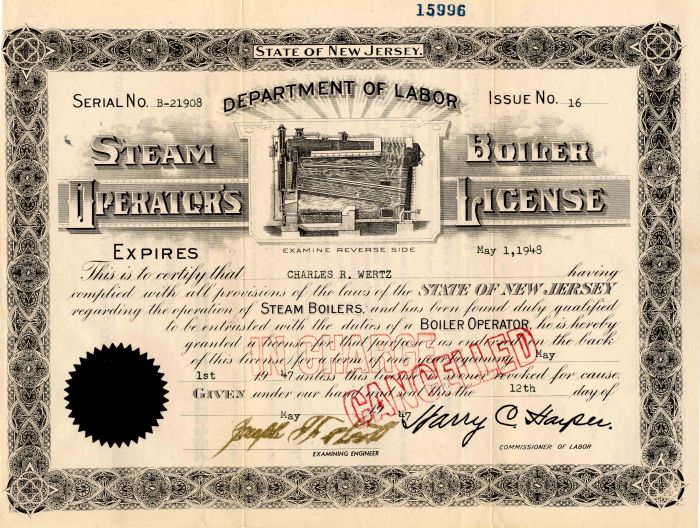Steam Boiler Operator's License - Department of Labor Certificate
Inv# AM1401
Steam Boiler Operator's License issued by the Department of Labor from the state of New Jersey. Included are 1937, 1938 and 1941 damaged licenses.
A boiler is a closed vessel in which fluid (generally water) is heated. The fluid does not necessarily boil. The heated or vaporized fluid exits the boiler for use in various processes or heating applications, including water heating, central heating, boiler-based power generation, cooking, and sanitation.
In a fossil fuel power plant using a steam cycle for power generation, the primary heat source will be combustion of coal, oil, or natural gas. In some cases byproduct fuel such as the carbon monoxide rich offgasses of a coke battery can be burned to heat a boiler; biofuels such as bagasse, where economically available, can also be used. In a nuclear power plant, boilers called steam generators are heated by the heat produced by nuclear fission. Where a large volume of hot gas is available from some process, a heat recovery steam generator or recovery boiler can use the heat to produce steam, with little or no extra fuel consumed; such a configuration is common in a combined cycle power plant where a gas turbine and a steam boiler are used. In all cases the combustion product waste gases are separate from the working fluid of the steam cycle, making these systems examples of external combustion engines.
The pressure vessel of a boiler is usually made of steel (or alloy steel), or historically of wrought iron. Stainless steel, especially of the austenitic types, is not used in wetted parts of boilers due to corrosion and stress corrosion cracking. However, ferritic stainless steel is often used in superheater sections that will not be exposed to boiling water, and electrically-heated stainless steel shell boilers are allowed under the European "Pressure Equipment Directive" for production of steam for sterilizers and disinfectors.
In live steam models, copper or brass is often used because it is more easily fabricated in smaller size boilers. Historically, copper was often used for fireboxes (particularly for steam locomotives), because of its better formability and higher thermal conductivity; however, in more recent times, the high price of copper often makes this an uneconomic choice and cheaper substitutes (such as steel) are used instead.
For much of the Victorian "age of steam", the only material used for boilermaking was the highest grade of wrought iron, with assembly by riveting. This iron was often obtained from specialist ironworks, such as those in the Cleator Moor (UK) area, noted for the high quality of their rolled plate, which was especially suitable for use in critical applications such as high-pressure boilers. In the 20th century, design practice moved towards the use of steel, with welded construction, which is stronger and cheaper, and can be fabricated more quickly and with less labour. Wrought iron boilers corrode far more slowly than their modern-day steel counterparts, and are less susceptible to localized pitting and stress-corrosion. That makes the longevity of older wrought-iron boilers far superior to that of welded steel boilers.
Cast iron may be used for the heating vessel of domestic water heaters. Although such heaters are usually termed "boilers" in some countries, their purpose is usually to produce hot water, not steam, and so they run at low pressure and try to avoid boiling. The brittleness of cast iron makes it impractical for high-pressure steam boilers.
The source of heat for a boiler is combustion of any of several fuels, such as wood, coal, oil, or natural gas. Electric steam boilers use resistance- or immersion-type heating elements. Nuclear fission is also used as a heat source for generating steam, either directly (BWR) or, in most cases, in specialised heat exchangers called "steam generators" (PWR). Heat recovery steam generators (HRSGs) use the heat rejected from other processes such as gas turbine.










Ebay ID: labarre_galleries